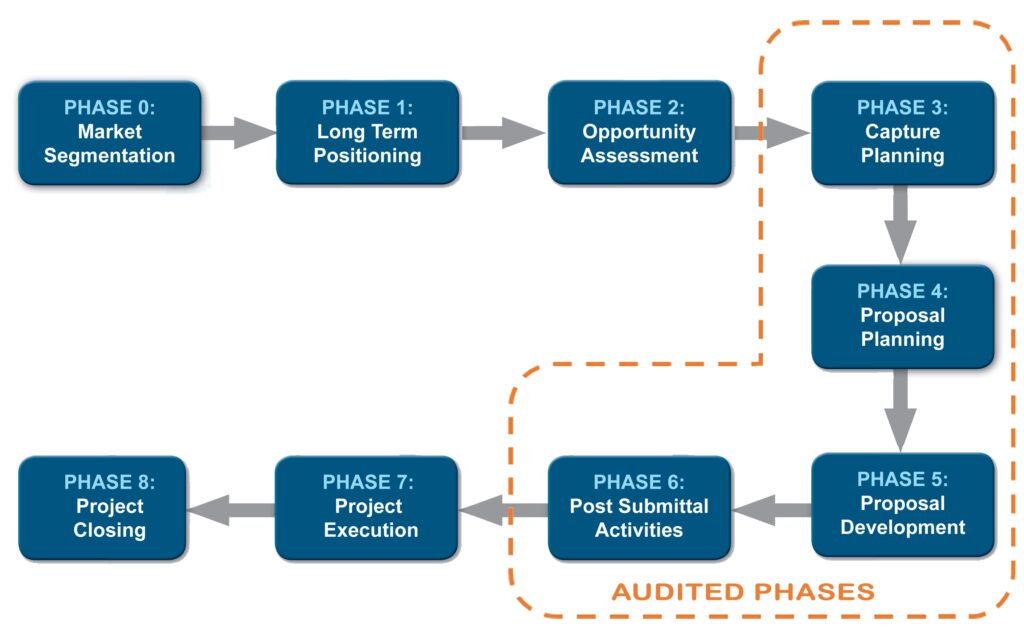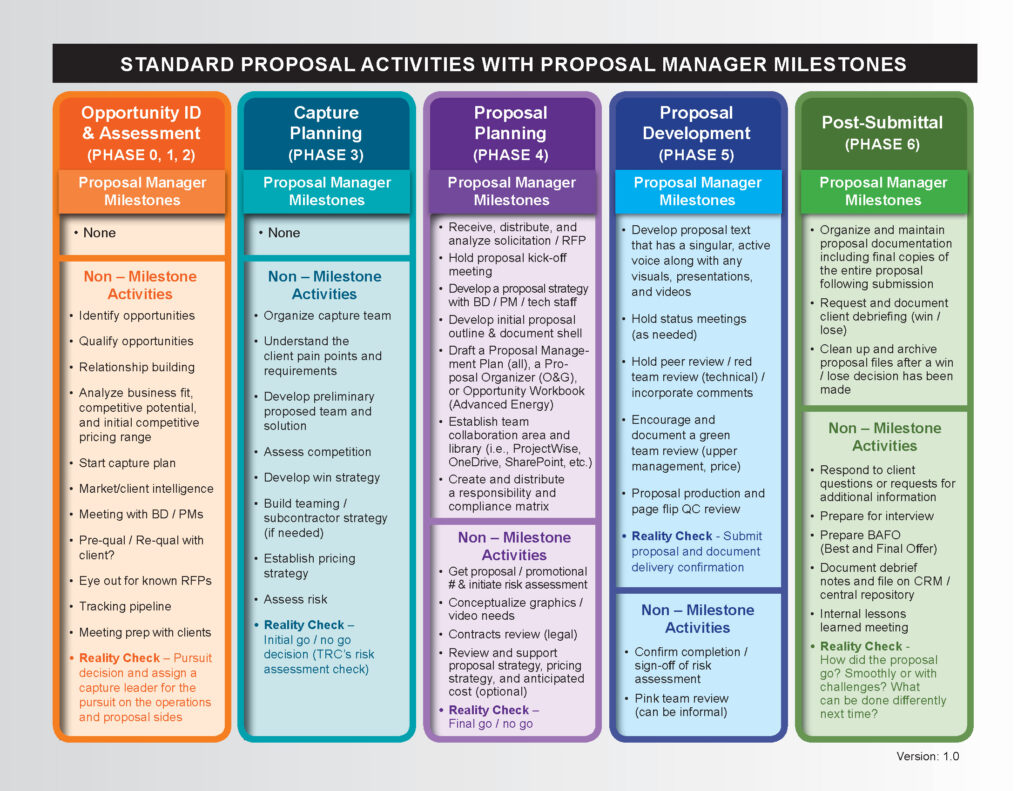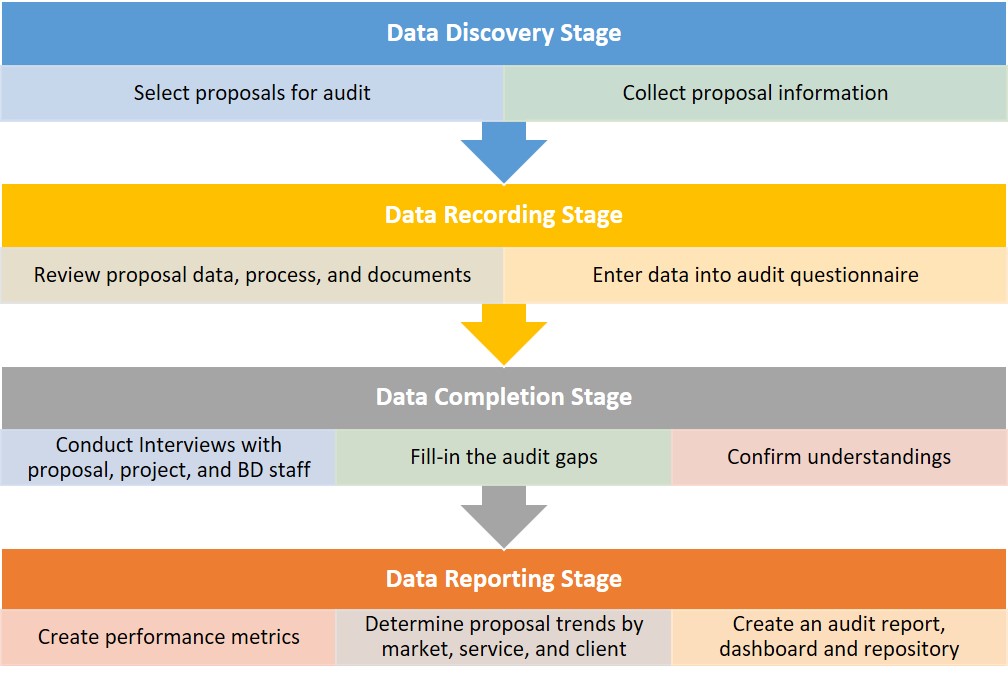When you hear the word “quality,” the definition you have might be different from the definition of those you work with. The American Society of Quality acknowledges the term’s subjectivity and suggests two meanings: “1) the characteristics of a product or service that bear on its ability to satisfy stated or implied needs; and 2) a product or service free of deficiencies.” Quality, like beauty, is often in the eye of the beholder; however, unlike beauty, quality is a concept that can be molded into a singular design by a company’s branding, corporate expectations and client base.
Oftentimes with proposals, a disengagement of concept can invoke inconsistencies in how a company communicates from practice to practice, sector to sector, market to market. These inconsistencies in proposal quality can force the “one voice” of a company to break into a cacophony of voices, visuals, messages and styles that ultimately tell the story of a company that is disjointed, focally fractured and possessing no united front.
A proposal process quality audit is a giant step toward remedying these counterefforts and can help mold a new pathway toward a unified, consistent and effective voice for your company. A process quality audit helps monitor compliance with your established proposal process and best practices, while exposing those areas in need of stronger adherence.
The following recommendations were developed through my own experiences with company-wide inconsistencies, and my trial-ridden steps using proposal process audits to sculpt a unified baseline of proposal quality. Hopefully, these steps will provide secure guideposts for you to develop your own program.
Understand your audit objectives. Perhaps the single most vital step in any program is understanding what you want to achieve with a proposal process audit. Is it merely consistency throughout your company or a permanent guidepost for all employees? Do you want to ramp up the level of competitiveness in your submittals or just enforce certain proposal best practices across the company? Understanding the realistic outcomes of an audit program will enable you to properly communicate and implement the program you want with full employee buy-in.
Determine your quality viewpoint horizon. When creating your process audit program, you initially need to understand the baseline level of quality you wish to meet. Consider it your viewpoint horizon for quality expectations — the minimum quality requirements for a successful proposal effort. Anything above this horizon has value, visibility and bearing, whereas anything below this horizon is imperceptible and holds little effect. Furthermore, the more positive activity beyond the quality minimum, the greater the impact of the entire effort. Think about the sun before sunrise (hidden), at sunrise (brought into view) and at high noon (powerful and dominant).
Build a single proposal process. Your proposal quality horizon begins with an inclusive, singular proposal process with resolute best practice milestones. If you have not done so already, spend ample effort creating an encompassing, reality-based process that fits all nooks and crannies of your company’s business service lines. Don’t do this in a bubble. Get the right people involved to facilitate buy-in from division leaders and upper management and, ultimately, staff. The process must be holistic and scalable so that the business of today and tomorrow can follow this same process.
For my program, I based the overarching proposal process on Shipley Associates’ 96-step business development lifecycle. However, 96 steps were too onerous and not befitting of the company’s needs. Working with my proposal staff and BD personnel embedded in our service practices, we were able to settle on an eight-phase inclusive process housing roughly 16 mandatory milestones and 34 optional ones.
An example of a mandatory proposal manager milestone is conducting a formal kick-off meeting, whereas an example optional proposal manager milestone is conducting a pink team review. This approach provides flexibility for every part of the business, offering a macroscopic roadmap with a menu of mandatory and optional stepping stones toward expected and ultimate quality. The following figure highlights the various mandatory and optional proposal manager milestone I implemented in my company; however, each company has different needs, and your milestones may look different.
Audit workflow and key performance indicators. With the singular proposal process in place, you will need to develop an audit process workflow to ensure adequate data collection, analysis and reporting. My process audit workflow consisted of four stages: a data discovery stage, a data recording stage, a data completion stage and a data reporting stage.
Simply stated, the data discovery stage involved the selection of proposals for audit and the initial data call to the proposal and project managers. The data recording stage involved the behind-the-scenes absorption of the initial data into the audit questionnaire. The data completion stage involved interviews with key staff (project, proposal and BD) to fill in the gaps of the audit and reconfirm that our understandings were correct. The data reporting stage involved an audit report, transparent online posting of audit results, and communication of any important trend analysis or metrics.
As a mechanism for the audit and objectives, KPIs need to be identified. For my audit program, we used only the mandatory proposal best practices derived from the singular proposal process and disregarded any optional activities. They were previously communicated to the company and easily identifiable by staff. With this focus, these KPIs formed a succinct, structured core for the audit program.
Pilot, adjust and implement. As with any program to be implemented across a company, smaller “test runs” of the program allow insights into the effectiveness of the program while exposing potential hiccups. A good pilot of your program gives you time to vet issues or incongruities through feedback from participants and adjustments to the workflow or process.
Run the pilot with one division, one service area, one product line or just a small sample of the company’s population. Be transparent about the early nature of your program and be clear that you are not only getting the “kinks” out using their help, but you’re allowing them an opportunity for positive change within the company. Ask questions and implement honest feedback loops with the pilot group to gain the best insights. Incorporate the changes that you feel are most impacting, and, when complete, you will be ready to implement the program to a much larger audience, perhaps even companywide.
For example, I first ran a pilot of my audit program with a group of 15 proposal managers from various service areas, which allowed me to identify questions that were too specific, confusing or misleading; drop-down selections that were incomplete; ways to combine some questions; and ways to garner better input and comments. Once I finished my pilot program, the initial audit questionnaire was unrecognizable from the implemented version.
Determine metrics and trends for improvement. Now that the program is up and running, what do you now do with the data being acquired? Start by going back to your program objectives to distinguish what proposal quality metrics and trends you want to use for future process improvements. Performance metrics are generally what a company does and proposal trends are generally what a company sees. Concerning metrics, they should be directly related to the proposal process and best practices. Metrics can be simple, such as the time it takes an RFP to go from client’s release to the desk of the proposal manager or the percentage of submitted proposals that go through a true Red Team review. Metrics can also be more discriminating, such as analysis of proposal costs versus net service revenue (return on investment) or classifying service groups by their adherence to the proposal milestones or some other quality identifier.
Proposal trends can be a bit more flexible and overarching. An example trend can be the average client, market and/or service area time frame from the RFP release to the due date. Another trend can be collective reasons why your company is awarded contracts or loses opportunities in relation to client preferences, market demands, proposal deficiencies, competitiveness or fiscal reasonableness. Trend analysis can be elaborate as you desire; however, be careful not to fall down a rabbit hole. As the saying goes, “paralysis through analysis.”
With these steps, you can develop a scalable and successful proposal process audit program. Start small and build on. Use metrics, analysis and trends to develop an improvement plan for your company. Learn from your company’s successes and failures, while becoming more resilient to change course as the market and client demands change. Overall, have some fun with the program and make it your own. If you maintain the integrity of the program and data gathering, you’ll have the basis for real proposal excellence.
Dr. Stephen R. Galati, CGW, CP APMP, is the director of strategic proposals and practice quality leader for TRC Companies, Inc., a $1.3 billion global engineering and environmental firm. He can be reached at [email protected].







Join the Conversation